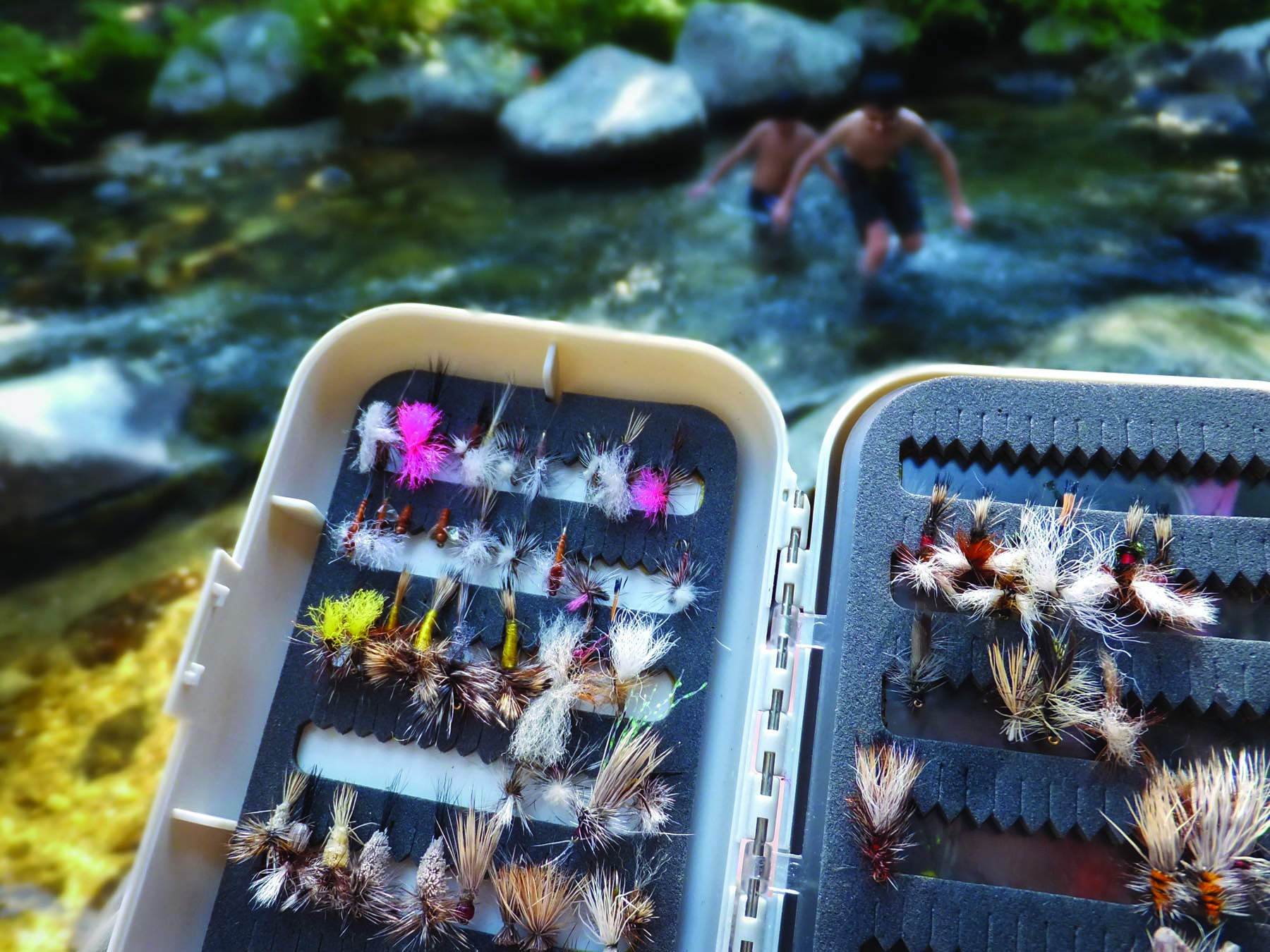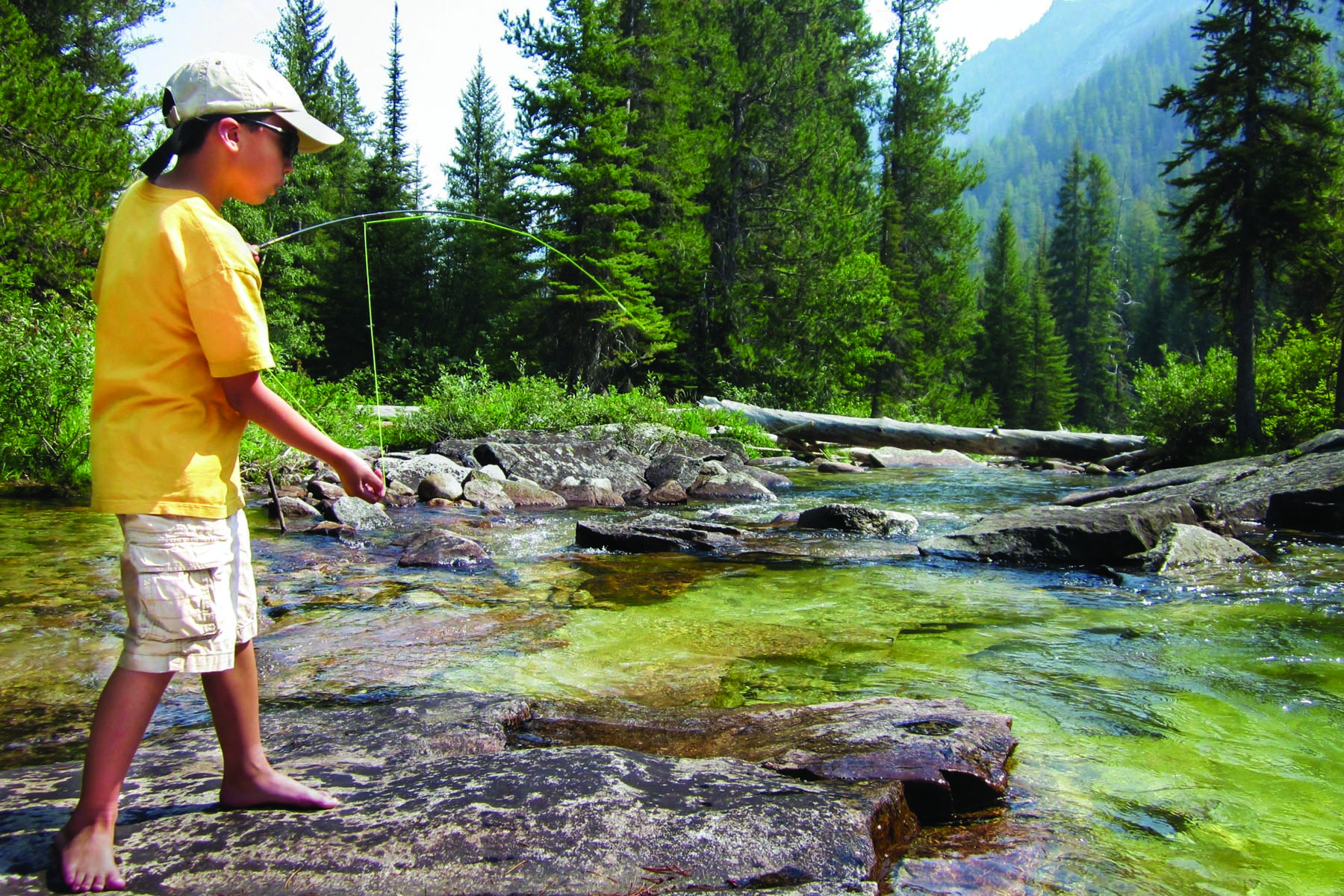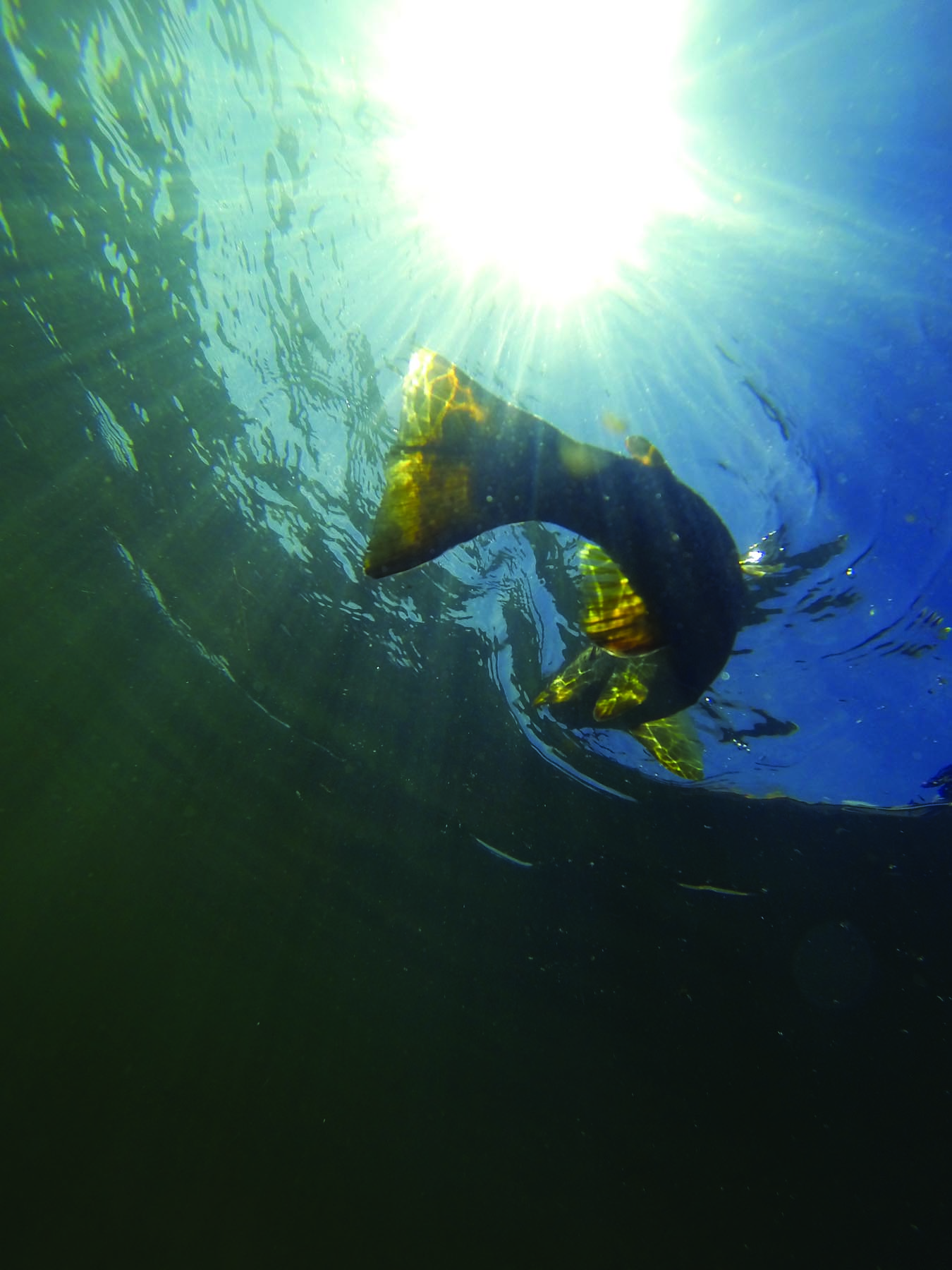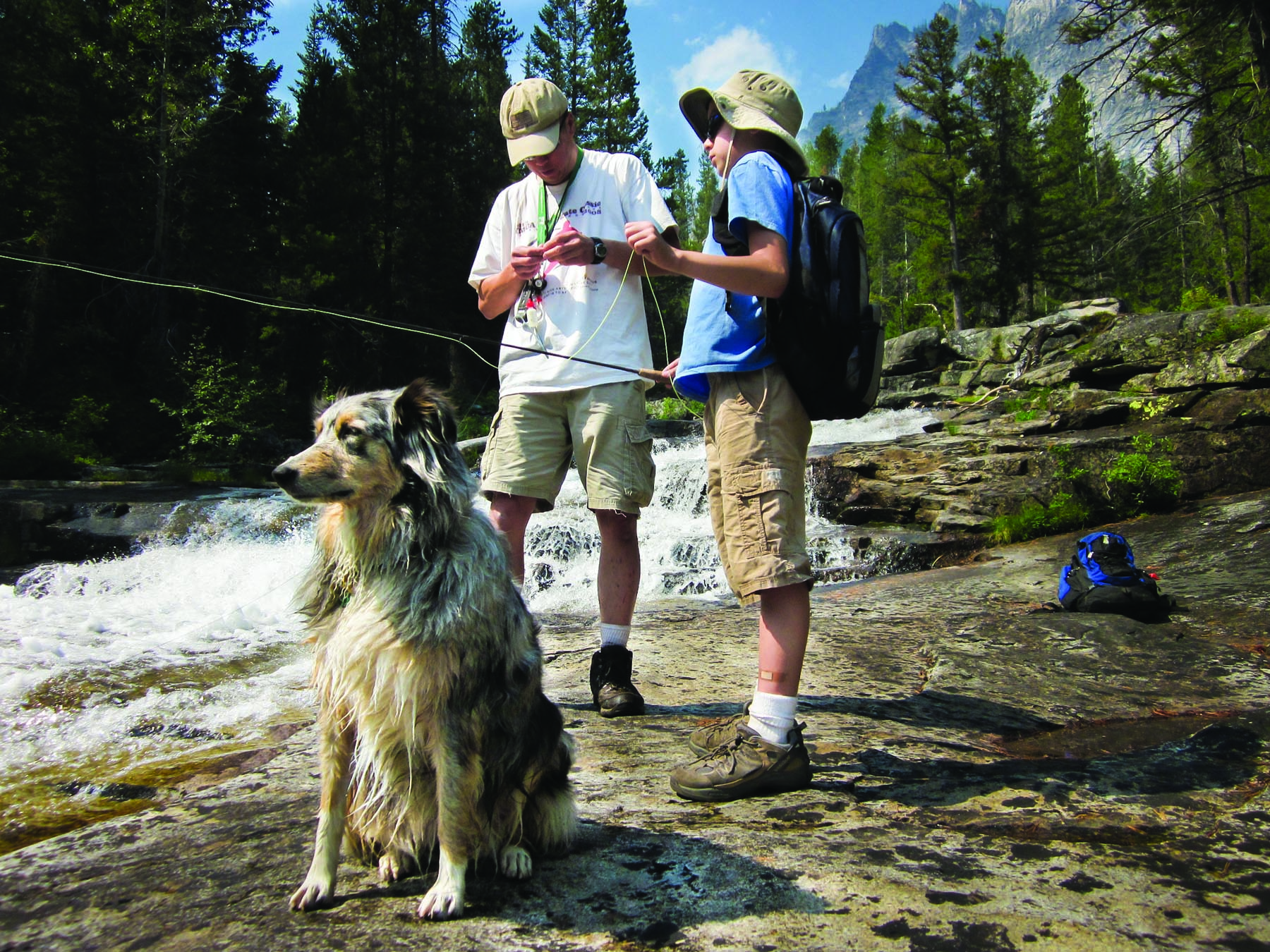
01 Sep Catching Bob
WE HAD JUST WALKED ACROSS the bridge when a pickup truck rumbled past. Three seconds later, the truck’s taillights glowed red, then white, as the driver stomped on his brakes, backed up with a spurt of gravel and hit the button for his window. Big truck, big mustache. My husband and I stared in at him, each of us with one hand on a kid and the other hand on a fly rod.
Mustache guy looked grim. “This isn’t a good place for you to fish,” he began, as he launched into a polite but stern two-minute lecture. This stretch of water was too dangerous, he told us, especially for children and beginners. The current was too strong and we needed proper equipment, including waders. At this, he seemed to cast a judgmental eye over our ratty tee shirts and shorts — no fishing vests; no cape-vented, quick-dry shirts; no pricey waders in tasteful shades of khaki and olive.
I wasn’t sure how to react to this strange mixture of generosity (he thought he was saving our lives, after all) and condescension (we needed to be saved from our own stupidity). So I just nodded and smiled and waved him on. As the truck disappeared from sight, my husband and I looked at each other through the settling dust. What had just happened?
“Maybe he’s trying to be nice,” I said. “He thinks we’re a danger to ourselves and our kids.”
As snap judgments go, it was a nice change. At airports, we’re the family viewed as a threat to national security. But I didn’t understand the man’s insistence on waders. Even though it was July, water was still running high; wouldn’t we be nuts to get in?
Tony shook his head and frowned. In his job as a law enforcement ranger, he often pulls down “No Trespassing” signs posted on public land. “Just trying to keep a good fishing spot for himself. Let’s go.”
Now unsupervised, we ducked down the trail above the bridge. Mustache guy was right about one thing; fast water could be dangerous. Here, on one of our favorite Bitterroot tributaries, many places would be unsafe to fish with kids until late summer. But he needn’t have worried about us. We weren’t headed toward the risky bits, or even toward any of the fine fishing holes that might trigger his protective instincts. Our goal that morning was a marginal pool with a tiny, sandy beach and a gentle shoreline where, if you fell in, you would get wet and that’s about it. We were there to catch Bob.
Tony and our youngest son had made Bob’s acquaintance the previous day, when Quinn had allegedly caught the same cutbow seven times. The fish’s name, he said, was Bob. And Bob was, in his words, “a dumb fish.”
When we arrived at Bob’s beach, we found the damp sand marked with tracks where an adult deer and fawn had gotten a drink, evidence that mama doe agreed with our assessment: This was a safe place for little guys. Here the banks widened and flattened, slowing the stream’s pace. Years of high water had pushed back the willows and conifers, leaving a nice opening in the forest canopy for short casts, possibly even by short casters.
“So where does Bob live?” I asked Quinn.
He pointed to a small, shallow eddy with a few scattered rocks. As trout neighborhoods go, it was extremely modest. But the water was clean and cold, and a nearby ribbon of current delivered a steady supply of groceries.
Tony handed over his fly rod and Quinn pulled line while checking his back-cast — not bad for a 6-year-old. Then he casually tossed his parachute hopper into the pool, drifting it right past a hidey-hole by a rock. The grasshopper disappeared with a blip. Quinn hauled in a fish and held it in the water so we could take a look.
“Is that Bob?”
“Uh-huh.”
Our son Jaren, nearly 10, looked unimpressed — we had been staying at a cabin upstream for the last few days and he was fished-out. And Bob was a squirt, just 5 or 6 inches long. But I still found something appealing about the tiny cutbow. In movies for kids, animators usually draw fish with eyebrows and pupils and the ability to blink and smile nicely. Yet even without those additions, Bob was a cutie, with his big baby-trout eyes, weak chin and greeny-gray parr marks superimposed on a delicate rainbow stripe.
Quinn released him carefully and tried again. I thought Bob would dart back to his rock and sulk for a while; despite his flat affect, I’d gotten the feeling he wasn’t happy to see us. But in minutes Quinn was reeling in another small cutbow, identical to the first.
“Bob again?”
“Yeah,” Quinn said.
It wasn’t impossible. I realize that Bob may have been a female or a whole school of fish of similar age and size. But Quinn has always been a skeptic, the kind of kid who would see a guy in a red suit carrying a bag of toys and have him arrested for trespassing, maybe even stalking (“He sees you when you’re sleeping,” etc.). I decided to take his claim on faith. And if he was right, we had cause to be worried about Bob.
A certain amount of eager-beaver spontaneity is required for life on small streams, where a trout may have one chance to pounce before a tasty bite cruises out of range. But even a fish needs to learn from its mistakes. I wondered how Bob could survive if he’d try anything once, maybe as many as seven times in a row, with no concern for the consequences. If he were a human teenager, he would be experimenting with substances and passing on double yellows.
“Let’s give Bob a break for a while. We can always catch him next time.”
“Awww … ”
“No, really. We need to pack.”
Quinn reeled in his line and we all walked back, a bit glum, across the bridge and up the road to the cabin. Our last day there was always the hardest.
The cabin looked just as you would expect if you didn’t expect too much: one room, log, accessorized by an outhouse and a woodshed. Give a child a box of crayons and a request to draw a cabin, and there you have it. there. If it’s cold, make sure you supply a gray crayon so the child can draw smoke spiraling out of the chimney. The cabin would seem a bit cliché if it were new, but it was old and historic and in some strange way felt like home — the archetype.
Our stays there weren’t perfect. We always brought a bottle of bleach and felt relieved, following our trips, once we survived the incubation period for hantavirus. But the place offered us a sense of peace and isolation — a perfect mix of meadow and mountain and stream — that nothing else could replace. At least once each summer, we rented the cabin for three or four days and shared bunk beds each night while telling stories about a short, sensitive Sasquatch and waiting for the packrat to begin its assault on the perimeter. During the day, we hiked a little, rode bikes on the circle driveway until our dog got dizzy, and went fishing.
It wasn’t the only place our kids fished, but it was the only place they fished a lot. A couple of months after we said goodbye to Bob, I counted eight occurrences of the phrase, “then we went fly fishing again,” in Jaren’s “What I did on summer vacation” essay. In a school paper, it was redundant, but in real life, it was fun. The boys learned how to fly fish in small doses, sometimes just 15 minutes at a time.
As dictated by tradition, we returned to the cabin the next summer. Lower stream flows opened up our options for fishing with the kids. By afternoon we found ourselves — no surprise — all snarled up on the bank below the fire pit. When you’re teaching kids to fish, hooks fly everywhere. That’s one reason we always insist that the boys wear sunglasses (which might as well be polarized, right?). Our kids have fished in their skivvies before, but not, to my knowledge, without their sunglasses.
Tony was detangling a mass of knots while the boys tugged at a fly hooked in the back of his shirt. They were snickering. For parents, snickering usually requires further investigation, as it may uncover experiments with mud shampoo, permanent-marker tattoos or similar sources of entertainment. I heard a small hacking sound followed by more snickering.
Tony’s head swiveled around. “Hey, why is my back wet?”
After a short conference with Jaren, Quinn took the fall. “You said to spit on the fly.”
“On the knot.”
Tony says it helps the loops coil tighter. Kids like to spit, anyway, so why not?
“Oopsie.”
We snipped and unpicked and straightened before trying a few of the safer holes along the stream. Jaren celebrated when not following my advice worked for him: “Hey, Mom, look what I caught with a lousy drift and my shadow on the water.” Not bad, though kids should listen to their mothers.
Just downstream, Quinn pulled in a cutbow and kneeled down to remove the hook. “I think it’s Bob.”
The fish was about the right size — 7 or 8 inches — with that same combination of speckles and slashes and subtle iridescence. “How do you know that’s Bob?” I asked. “This isn’t where you caught him last year.”
“I don’t know. I just think.”
Quinn released his grip and the fish known as Bob, at least temporarily, slunk away into a tangle of roots. If it was Bob, he was learning, albeit the hard way. He did not come back for more.
When we returned to the cabin in August the following year, the weather was so hot and the water so low that the boys spent most of their time swimming. But with the stream thermometer showing a temperature of 52 degrees, we still fished a little in the mornings. About a mile below the bridge, we found an enormous pool at the base of a well-defined trail. The far side of the stream pushed against a steep rock wall; the other lapped at a ring of rocks near our feet. The hole looked so conspicuously perfect we expected it to be fished out. But Jaren took just three or four casts to catch a big, fat cutthroat — this time with a nice drift and his shadow off the water. It pays to listen to your mother.
As I was watching the boys, a deer fly attacked my forehead and tried to excise its bit of flesh. Usually a smack will drop a deer fly in a satisfying act of revenge, but this one wouldn’t let go. “It’s a fly!” Jaren yelled.
“I know,” I said, still slapping myself in the face. “It’s a mean one.”
When I finally scraped it off with my fingernails, the fly turned out to be a loop-wing emerger, attached to a tippet that eventually led its way back to a kid. I got it, then — a fly. I used the emerger to catch my own big, fat cutthroat. So I guess it was worth it.
Quinn interrupted his search for frogs to release the fish for me. He held the cutthroat in a gentle current for a few moments before letting it slip through his hands. “Is it bigger than the rainbow I caught on the Teton River?”
“No,” I said.
“Yay.”
He hadn’t fished much lately — “too mean,” he’d told me. I had a feeling he was just holding off until I hooked a fish bigger than his monster rainbow, which had seemed even more impressive in contrast with the small fisherman who had caught it, at 4 feet tall, while wearing a ratty tee shirt, track pants and polarized sunglasses. The fish hadn’t made much of an impression on him at the time, possibly ranking lower than Bob. Yet its legend had grown over the past couple of years, which I’d spent unsuccessfully trying to break his record.
The boys and I left Tony to his fishing and hiked back to the road, wet dog trotting ahead. As we crossed the bridge, I looked down at the tiny beach now washed clean of fawn tracks and small sneaker prints.
“How many times did you catch Bob that first year? Wasn’t it seven?”
“It was eight,” said Jaren, outpacing me on his long legs.
“Maybe nine,” said Quinn, keeping up easily now at 4-and-a-half feet tall.
They were learning to exaggerate like true fishermen.
“Do you want to try to catch him?” I asked.
“No,” Quinn said. “Bob moved on.”
I guess he did.
- In search of Bob, Quinn sets the hook on a fish in Blodgett Creek. Photo by Julie Lue
- Photo by Craig Hergert
- A little hiking and a lot of fly fishing defines summer for Quinn and his family. Photo by Julie Lue
- On the lookout in Blodgett Canyon, Scout sits patiently as Tony changes a fly on Jaren’s line. Photo by Julie Lue








No Comments